resources
Level of surfing
Advanced
Quality of surf
Excellent
Call code
62
Net code
id
Area
1919440
Coastline
54,716 km
Climate
Tropical; hot, humid; more moderate in highlands
Hazards
Very Isolated, Difficult Access
Best Months
May - September
Population
234693997
Currency
Rupiah (IDR) Indonesian rupiah per US dollar - 9,159.3 (2006)
Time Zone
(UTC +7) to (UTC+9)
Special Requirements
Private Beaches, Strict Religious Observance
introduction

Map of Indonesia
Indonesia is a true surfers paradise. The southern shores of all of the islands from Timor through to the Mentawai’s receive excellent long range groundswell origination in the deep field of Antarctica. Like all things that seem to be to good to be true however, they are. Indonesia has the largest Muslim population in the world and the global problem of religious inspired terrorism has manifested itself in the once pristine paradise of Bali.
Once a popular destination for Australian, New Zealand, British and American tourists, the 2002 and 2005 Bali bombings resulted in the deaths of 202 and 20 people respectively with an additional 340 people injured by both events. Indonesia has since launched her own ‘War on Terror’ to combat the problem. However, confusing images showing convicted Bali bombers being permitted to leave prison and attend anti western rallies seem to paint a very different picture. The real tragedy here is that suffered by the people of Bali. Bali is the only non-Muslim dominated island in Indonesia, with 93% of the population practicing Balinese Hindu’s. It is regrettable that these peaceful people have been forcably embroiled in a conflict that they have no vested interest in whatsoever.
history
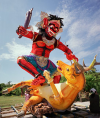
Mark Johnson: Ogahogah, Kuta; 2006
The 17, 508 Islands that comprise Indonesia were inhabited by Homo Erectus over 500,000 years ago. Homo floresiensis was possibly another species of the Homo Genus that managed to survive until quite recently on the Island of Flores. Due to the process of island dwarfism, these proto humans were probably no more than a few feet high. Known by more recent Austronesianinhabitants on Flores as the Ebu gogo, these hairy cave dwellers were likely to have been present during the Dutch arrival in the 16th century and may have persisted through until the 19th century.
Buddhist and Hindu kingdoms were established in modern day Indonesia around 1000BC. Gradually, Islamic traders introduced their religion to the area and by the 16th century the region had a unique form of Indonesian Island with the exception of Bali that was to remain predominantly Hindu. It was the rich spice trade that attracted the Portuguese in 1512. The island of Timor remained a Portuguese protectorate until the 1970’s. Dutch and British traders were to follow and by 1800, the area was officially established as a Dutch colony and known as The Dutch East Indies. The Dutch maintained control over the area until the World War II Japanese invasion. After the war, the Dutch attempted to regain control of the area but eventually recognised Indonesian Independence in 1949. Indonesia’s recent history has been politically turbulent. Their 1975 invasion of East Timor was left to run largely unchecked due to Australian and United States forces demobilising after the Vietnam Conflict. Vietnam was an unpopular conflict and neither countries population was prepared for another similar struggle in south East Asia. East Timor was to eventually realise independence in 1999 with the aid of a UN peacekeeping force led by Australia. The successful result led Osama Bin Laden to place a fatwa on Australia and Australian interests. Indonesia suffered terribly from the Boxing Day Tsunami event of 2004 with over 150,000 people losing their lives, primarily in the province of Aceh. Humanitarian aid funded principally from organizations such as Surf Aid is still ongoing in this region. Terrorism and the threat posed by the associated political instability of such cells continue to be the main challenge facing Indonesia and her economy for the future.
surfing

Slivester Nuenenorl cor Bounifeuisc: The Affinity of Stadérrouté; Bali 2005
A pitching deck, the creak of well-worn timbers, the cracking of sail and canvas...tied to the mast. Things have changed a little I guess from when Jack London and Josef Conrad wrote their haunting Pacific infused epics but it hasn’t changed everywhere. There are corners of this earth where that myth still holds true, and most of those corners are here in the South Pacific. The main source of swell here is from the intense lows that circle the earth south of Australia, these lows spin off northwards with blessed regularity, peppering the entire region with generous SE to SW groundswell from March to September. Australia and New Zealand see the bulk of these swells. These countries cast a very tall shadow across the rest of the Pacific and hence many other islands in their wake can suffer from swell diffusion. December to February is cyclone season. Unpredictable cells can deliver swell in a 360 radius, lighting up rarely breaking reefs and points facing every conceivable direction.
The South Pacific trade winds are some of the most consistent in the world, generally from the East with slight seasonal variation. This is the largest Ocean on the planet and these winds easily generate regular rideable swell. Onshore conditions can be a problem on east facing coastlines but peeling yourself out for an early surf will usually bring some relief.
In the North Pacific it is the intense lows descending from the Aleutians that deliver NE to NW swells from October to March. Hawaii is ideally placed to make best use of this energy but other coastlines in the region have their own less publicised and far less crowded gems.
Jun to October also sees rarer hurricane swell radiate out from southern Mexico. This energy is often felt right throughout Polynesia. With so many energy vectors at work it is very hard not to find a wave.
Places such as Indonesia that offer rideable options on every coast will ensure that regardless of the conditions, somewhere there will be a wave. In fact quite often there will be a very good one.
Options abound throughout the country for the surfer. All of the higher quality and named breaks are found along the southern coasts of Sumatra, Java, Bali, Timor and inter joining islands. The northern islands offer somewhat limited options due their close proximity to the larger landmasses of south East Asia. The islands of Sulawesi and Borneo are completely blocked from both the Indian and Pacific oceans and offers no serious surfing potential. The northern coasts of Irian Jaya and the islands of the Moluccas are exposed to the North Pacific and offer virtually unexplored options for the surfer. Much of this country is extremely remote and travel can be both very expensive and hazardous. Exercise due caution if embarking upon such an expedition.
travel
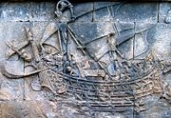
Michael J Lowe: Relief panel of a ship at Borobudur; 2005
You have a lot of options as to where you would like to start your journey in Indonesia, a lot will depend on just how much time you have. If you only have a week it is hard to go past Bali. You can fly directly to Denpesar airport and commence your odyssey from there. The island has been set up to truly cater for surfers and many of the local drivers will be able to take you to the named spots. Drivers and guides are very cheap and are a much better option than trying to drive yourself, especially if you are not that familiar with driving in south East Asian countries. Trips to many of the nearby surf island destinations such as Lombok and Sumbawa depart from Bali as to trips to the more distant Mentawai Islands such as Nias. Java is often overlooked as a surf destination in view of Bali but can offer world-class waves often with far smaller crowds than neighbouring islands. Flying into Jakarta is your best option here, hire a car and scour the coast from west to east for a week – you will be rewarded.
weather
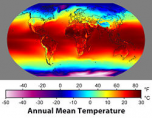
Robert A. Rohde: Annual Average Temperature Map, 15 February 2008
The Indonesian archipelago straddles the equator and lies in the area influenced by the position of the Intertropical Convergence Zone. As such it has a tropical monsoon climate with typified by cloudiness and precipitation, warm temperatures, and high humidifies, that is characterised by two monsoons. Maximum day time temperatures close to 30 degrees or above year round, water temperatures in the mid to high 20’s, makes Indo weather ideal for surfing for at least 6 months of the year. Transition periods and actual onset times for these monsoons vary from one end of the island groups to the other, but the mean months divided into the Wet Season (November - April) and Dry Season (May - October).
Northeast Monsoon (Wet Season) (Nov – April)
During these months the subtropical ridge is at its farthest south and the thermal high over Australia has been replaced by a thermal low. This combination pulls the monsoon trough (trade wind convergence zone) into its farthest south position of the year lying across Java by December and south of the islands in January. With most of the main surfing locations in the southern hemisphere, you can expect the wettest weather over the famed surfing breaks during this period. This wet weather is brought in by the monsoonal winds from the northwest and their convergence with southeast trade winds. The transition to the wet season begins in October in Sumatra and Java and in early November further east and it is on everywhere by the end of November. The number of rain days peaks with the passing of the trough and varies from across the archipelago. Java has the most rain days in November to January at 15+, and further east over Bali, Lombok and Sumba have the most rain days in January through April at 12 to 15. Mean high temperatures are between 29C and 31C. The mean lows are from 23C to 25C.
Southwest Monsoon (Dry Season) (May – Oct)
The subtropical ridge is at its farthest north position by mid-June, and drags the monsoon trough north of the area and allows southeast trade flow to cover most of the archipelago by May and continues until October. This creates clean conditions for surfing at many of the better-known surf breaks from Macaroni’s in the Mentawis to Uluwatu in Bali. This is also the time that more intense low-pressure systems start to form through the Indian and Southern Oceans. Large, long period groundswell can travel 1000’s of kilometres once generated by these winter storms, reaching the exposed southwest coastlines of Indonesia with great power and size. With drier weather also occurring at this time of year, it is generally consider the golden time to go. The east islands are into the dry season as much as a couple of months earlier than Sumatra. The most rain in this season occurs in May and early June on Java and Sumatra with 6 days with rain. By July and August at most locations this drops to virtually 0. Mean high temperatures are between 29C and 31C. The mean lows are from 23C to 25C.
where to stay
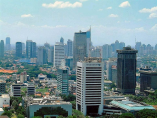
Kevin Aurell: Jakarta Skyscrapers; 2007
Lots of options right through Indonesia to suit every budget. Bali offers some of the best accommodation in South East Asia with many global chains of hotels offering luxury spa and retreat style accommodation – distances to surf vary so it’s best to check before the wife goes and books one with the best looking pool for the kids. Kuta will offer you the bets priced backpacker style accommodation for those on a budget. Bali as an island is still suffering the aftershocks of the 2002 / 05 bombings and a lot of hotels have suffered as a result. Those that have managed to survive are still offering very cheap accommodation in an attempt to lure once loyal customers back. The other islands can be a bit of a mixed bag – there are several family friendly coastal hotels run by surfers that attempt to offer the best of both worlds for the family with a surfer in their midst and do a very good job of it. Timor has basic clean hotels although it is probably not the best place to bring your family to right now. Java and Sumatra have many towns that can offer good accommodation but certain regions can be a little remote. Nias is the main island in the Mentawi’s and you can fly there. If you are thinking of spending some time on some of the more remote islands then a boat is definitely the way to do it. Many operators ply these waters with packages available to suit most budgets.
what to pack

Anopheles albimanus mosquito vector of malaria, CDC, Public Health Image Library (PHIL),
Malaria is still reported outside the major cities of the country so bring anti-malarials with you, don’t try to buy them in Indonesia. Worth checking that you are in date for all of your shots before you come as well, particularly tetanus. Depending on how sensitive your tummy is you may wish to bring your own stamatil, lomatil and other medicines that get you through 24 hour bugs. Don’t even think about drinking un bottled water unless you have a cast iron stomach – including ice in drinks. You will be in the tropics so remember sunscreen, hats and mosquito repellant.
dangers and warnings
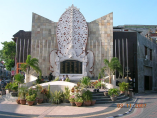
Jonathan Liem: The Bali bombing memorial on the site of Paddy's; 2007
Earthquakes occur in the area, the most devastating of course being the boxing day disaster of 2004. Major events have occurred on average every six months and are likely to be delayed aftershocks from the 2004 event.
Terrorism is a real danger, the most recent being the Bali events. Of course the reality is that many visitors are completely unaffected and will have a trouble free visit to the country. Political unrest is generally limited to Aceh, the Papuan border, central Sulawesi and the island of Ambon; be sure to check relevant government advisories prior to planning and travel to or through these areas.
Minor theft and corruption is common especially around the more popular tourist areas so appropriate levels of caution should be exercised.
restaurants, shopping and nightlife
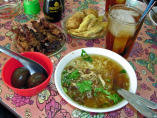
Merbabu: Indonesian food; 2006
There is a large variety of international and fast food in the major cities of Indonesia. In Bali and the other islands you can be fairly confident about the food in the hotels but be cautious of any salads or food that isn’t cooked. There are a few delicacies you should try depending on where you are. South Kalimantan offers excellent baked fish dishes with pork being very common in Bali. Northern Sulawesi specilaises in very spicy dog for the adventurous.
Many areas of Indonesia make traditional carvings and masks, the woodwork of Bali is particularly striking due to the Hindu / Buddhist influence. Be careful of purchasing any thing other than treated hardwood however as your own customs department may confiscate suspect items when you bring them home.
Nightlife will depend on your tastes. Bali probably has the best array of western style clubs and bars with Kuta being the hotspot of it all. There are many fine restaurants in the area that can offer a quieter alternative way to spend an evening. Jakarta and the major cities offer all the clubbing you could want with regional centres specialising in the more Indonesian businessman opinion of what a club should be like – so lots of karaoke, bar girls and blue lighting. A lot of these clubs take their karaoke very seriously so have a look around before you belt out a drunken version of Khe San that involves you twirling the microphone around and smashing it into the bar.
what to do when it's flat
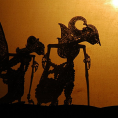
Jpatokal: Wayang kulit performance, Museum Wayang, Jakarta; 2005
Indonesia is one of the most geologically active areas of Earth. Mount Bromo in western Java is an active volcano and an easy daytrip from Jakarta. Bali itself as the last surviving vestige of Hindu culture in south east asia has some remarkable temples. Nias contains classic examples of tribal culture, ancient carvings and primitive construction. There are many fantastic sights within the Indonesian wilderness all accessible with an experienced guide. Do take appropriate measures against malaria when travelling however.
useful phrase guide

Devimahatmya MS in Sanskrit on palm-leaf, Bihar or Nepal, 11th c., 32 ff., 5x31 cm
Hello - Halo. (HUH-lo)
Hello. (informal) - He. (Hey)
How are you? - Apa kabar? (AH-pAh KAH-bar?)
Fine, thank you. - Baik, terima kasih. (BAYK, TREE-muh KUS-see)
What is your name? - Namanya siapa? (NUM-muh-nyuh shah-puh?)
My name is ______ . - Nama saya ______ . (NUM-MUH suh-yuh _____ .)
Nice to meet you. - Senang bertemu anda. (SNUNG burr-tuh-moo UN-duh)
Please. - Silakan. (see-LUH-kunn)
Please. (request) - Tolong. (TOH-long)
Thank you. - Terima kasih.
You're welcome. - Terima kasih kembali. (…)
Yes. - Ya. (EEYUH)
No. - Tidak. (TEE-duh), Tak (TAH)
Excuse me. (getting attention) - Maaf. (MUH-UFF)
Excuse me. (begging pardon) - Maaf, permisi. (…)
I'm sorry. - Maaf. (…)
Goodbye - Selamat tinggal. (…)
Goodbye (informal) - Dadah. (DUH-DUH)
I can't speak Indonesian [well]. - Saya tidak bisa berbahasa Indonesia [dengan baik]. (…)
Do you speak English? - Bisa bahasa Inggris? (…)
Is there someone here who speaks English? - Ada orang yang bisa bahasa Inggris? (…)
Help! - Tolong! (…)
Look out! - Hati-hati! (…)
Good morning. - Selamat pagi. (slum-mut PUH-GUEE)
Good afternoon. - Selamat siang.
Good evening. - Selamat sore. (…)
Good night. - Selamat malam. (…)
Good night (to sleep) - Selamat tidur. (…)
I don't understand. - Saya tidak mengerti. (…)
Where is the toilet? - Di mana toiletnya? (DEE muh-nuh TOY-leht-nyuh?)






